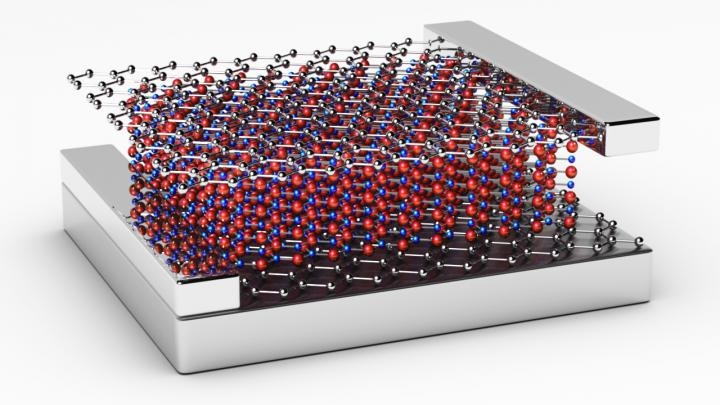May 19 2017
A number of projects are exploring ways to develop quantum bits or qubits as a result of the ongoing race to manufacture a quantum computer. Qubits are stable, that is, they are not greatly affected by environmental changes. This usually needs highly nonlinear, non-dissipative elements that have the potential to function at extremely low temperatures.
 This is an insulating boron nitride sandwiched between two graphene sheets. (CREDIT: Copyright EPFL/ LPQM)
This is an insulating boron nitride sandwiched between two graphene sheets. (CREDIT: Copyright EPFL/ LPQM)
With this goal, Researchers at EPFL's Laboratory of Photonics and Quantum Measurements LPQM (STI/SB), have analyzed a nonlinear graphene-based quantum capacitor, based on two-dimensional (2D) materials, and well-matched with cryogenic conditions of superconducting circuits. This capacitor, when connected to a circuit, is capable of producing stable qubits and also offering various other benefits, such as being moderately easier to fabricate when compared to several of the known nonlinear cryogenic devices and also being much less sensitive to electromagnetic interference. This research was featured in 2D Materials and Applications.
Normal digital computers function on the basis of a binary code made up of bits with a value of either 0 or 1. In quantum computers, qubits are used instead of the bits as the qubits can simultaneously be in two states with arbitrary superposition. This greatly enhances their storage capacity and calculation for specific classes of applications. However, making qubits is no mean feat: quantum phenomena need conditions that are highly controlled, including extremely low temperatures.
One promising approach that will help produce stable qubits refers to the use of superconducting circuits, most of which function based on the Josephson effect. However, they are unfortunately difficult to produce and sensitive to disturbing stray magnetic fields. This explains the fact that it is essential for the ultimate circuit to be extremely well shielded both electromagnetically and thermally, which precludes compact integration.
EPFL's LPQM explores this concept of a capacitor that is less prone to interference and less bulky besides being easy to produce. It is made up of insulating boron nitride added between two graphene sheets. The incoming charge is not proportional to the voltage that is produced because of graphene's unusual properties and this sandwich structure. This nonlinearity is considered to be an essential step in the process of producing quantum bits. This device could greatly enhance the manner in which quantum information is processed but there are also various other possible applications. It is possible to use this device for developing extreme nonlinear high-frequency circuits, all the way up to the terahertz regime, or for amplifiers, mixers and super strong coupling between photons.